By Ismael Peña-López (@ictlogist), 08 May 2007
Main categories: Cyberlaw, governance, rights, e-Government, e-Administration, Politics, Meetings
Other tags: idp, idp2007
1 Comment »
The Congress on Internet, Law and Politics has the aim of continuing the task of reflecting on, analyzing and discussing the main changes taking place in law and politics in the information society. This third congress focuses on the questions that currently represent the most important challenges and new developments in the fields of copyright, data protection, Internet security, problems of responsibility, electronic voting, and the new regulation of e-Administration, as well as dedicating a specific area to the current state of the use of new technologies by law professionals.
The aim of the new law is avoiding having to include tons of exceptions or specific cases on “analogue” law on the Public Administration. Thus, this new project provides a brand new framework that includes, on its ground basis, all kind of electronic approaches. Another big aim is to bring into this new framework absolutely all public services so they can be accessed digitally, not just a handful of them: the right to access the Administration, regardless of the platform or the means, is now the goal of this new law (actually in a draft/project version).
The e-Administration Law
Julián Valero, Professor of Administrative Law, University of Múrcia
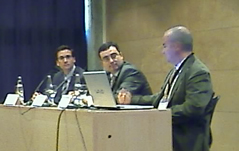 Left to right: Agustí Cerrillo, Juan Miquel Márquez, Julián Valero
Left to right: Agustí Cerrillo, Juan Miquel Márquez, Julián Valero
Law, a barrier? There is a crisis in the scope of Law, but Law should come first, and then technology, not the other way egovbarriers.org is just doing a research in this field: in what measure Law is a barrier to technology and technological change.
In this sense, the new law puts some order in some things that were already happening in a somewhat existing “legal void” related to technology and law. This does not mean that we have to forget all guarantees, but evolution is now a need, and the statu quo does not anymore give most answers to nowadays’ reality.
On the other hand, the challenge is to avoid entering into “fashion regulation”, and regulate each and every case as e-Administration when (a) maybe it is already solved or (b) maybe it requires highest level regulation instead of case to case regulation.
One of the best improvements of this law project is that it does not detail each and every procedure (as it was usually done until now), but just set a framework, and quite a flexible one. This is, of course, a good asset, as technology is so quickly changing that, as it had long happened, it overrode or invalidated the regulation framework.
A lacking question in this new law is networking: it is not the same thing information or communication (i.e. data sharing, data transmission), that working with the same information (i.e. working with the same databases), which should be (if it not really is) the reality and not just a hypothesis.
A couple of interesting links:
Last but not least: on one hand, the new law enables brand new paths, but, on the other hand, it does not empower little (i.e. local) Administration neither with sufficient budget nor with applications to go on and implant the law in its full scope. This might generate a divide among those Administrations that can and the ones that cannot implant full e-Administration as the law sees it.
3rd Internet, Law and Politics Congress (2007)
By Ismael Peña-López (@ictlogist), 08 May 2007
Main categories: Cyberlaw, governance, rights, e-Government, e-Administration, Politics, Meetings, Participation, Engagement, Use, Activism
Other tags: idp, idp2007
No Comments »
The Congress on Internet, Law and Politics has the aim of continuing the task of reflecting on, analyzing and discussing the main changes taking place in law and politics in the information society. This third congress focuses on the questions that currently represent the most important challenges and new developments in the fields of copyright, data protection, Internet security, problems of responsibility, electronic voting, and the new regulation of e-Administration, as well as dedicating a specific area to the current state of the use of new technologies by law professionals.
Do we need e-voting?
Josep Maria Reniu, Professor of Political Sciences, University of Barcelona
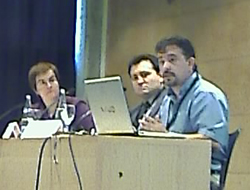 Left to right: Rosa Borge, Gerard Cervelló, Josep Maria Reniu
Left to right: Rosa Borge, Gerard Cervelló, Josep Maria Reniu
The digital evolution in the public arena is, clearly, slowed down by what happens with voting. And what is happening is, besides lots of pilot projects, few things: electronic voting is still in very early stages.
Nevertheless, the problem is neither lack of (pilot) experiences nor lack of tools and approaches, but a decisive step to implant e-voting. And the question is: do we really need e-voting?
Doubts on:
- Convenience + technooptimism: our actual system is simple [in Spain], thus there is “no need” to do it electronically in order to make it simpler. On the other hand, technological optimism needs reliability of the system, but it really is not that reliable.
- Cutting down costs: DREs are expensive. There still is paper as a voting receipt. And open source software is still not a standard, so customization is still expensive.
- More and better participation: experience have not demonstrated more or less participation. Pilot experiences replication causes weariness (“always experimenting, we want the real thing”). It is true that geographical distribution in participation has been improved.
- Elimination of invalid votes: not a doubt, but a statement. But, there are some voters that do want to express a null vote, hence, we are
- Democratic divide: due to digital divide.
- Security and voting guarantees: not 100% secure. Uncontrolled environments that do not guarantee free voting. Anonymity not guaranteed.
- Individual and collective verification: how to certify that one’s vote is there? And, on the other hand, free access to the source code is required to control the system… and one has to have the knowledge to understand it, so audits become non universal.
- Citizenship acceptation: technophobia, insecurity, lack of interest, tradition/liturgy.
Certainties on:
- Modernization of processes: flexibility of technology
- Cutting down on costs: paper
- increase of participation: some collectives such as expatriates. Appeal for youngest generations
- Several participative applications: languages, colors, etc.
- Need for an electronic ID card
- Need for specific voting authorities: competent to give confidence
- Coexistence of traditional voting and electronic voting: complementary, gradual
Conclusions: electronic voting does not solve anything; digital literacy is a need; a complementary solution; better participation will rely on better information of citizenship.
Secure Electronic Voting
Gerard Cervelló García, Public Administration Manager at SCYTL
What is not electronic voting: electronically managing votes at the backend system. By electronic voting we mean digitally expressing one’s vote.
[Gerard Cervelló gives an overview similar to Josep Maria Reniu’s. I’ll just add here the new topics, opinions, approaches]
Electronic voting offers fastest counting.
A smart option against the highest cost of DREs would be remote voting by means of personal computers, mobile phones or other devices that already exist in the hands (or in public centers such as libraries) of voters.
Requisites of electronic voting:
- usable: easy to understand
- accessible: for everyone
- available: no “sorry, I’m rebooting”
- reusable
- gives confidence: both to the voter and to the Administration
(Not) surprisingly, one of the barriers e-voting has to face is legal framework: most regulations for voting do not allow e-voting, because the way voting is described usually leave out i.e. remote voting, non paper voting, etc.
3rd Internet, Law and Politics Congress (2007)
By Ismael Peña-López (@ictlogist), 12 April 2007
Main categories: e-Government, e-Administration, Politics, Hardware
2 Comments »
Here comes the bibliography I’m using to teach my course Technological grounds of the e-Administration belonging to the Master in e-Administration at the Universitat Oberta de Catalunya.
Bibliography
Fabra, P.,
Batlle, A.,
Cerrillo, A.,
Galiano, A.,
Peña-López, I. &
Colombo, C. (2006).
e-Justicia: La Justicia en la Sociedad del Conocimiento. Retos para los países Iberoamericanos. Santo Domingo: ejusticia.org. Retrieved October 07, 2006 from
http://www.ejusticia.org/component/option,com_docman/task,doc_download/gid,89/lang,es/
Further information
This is not a evolving selection, though it might have slight changes. The up-to-date version of this list can always be consulted here: Fundamentos Técnicos de la Administración Electrónica. Feel free to write back to me with proposals for inclusion in the list and/or corrections for found errors.
By Ismael Peña-López (@ictlogist), 19 March 2007
Main categories: Cyberlaw, governance, rights, e-Government, e-Administration, Politics, Meetings, Participation, Engagement, Use, Activism
No Comments »
Just like last year, at the Faculty of Law and Political Science of the Universitat Oberta de Catalunya we are organising the III Congress on Internet, Law and Political Science that will be held in Barcelona (Spain) on May, 7th and 8th, 2007.
I honestly think the program is getting better each year, being one of the strong assets for this edition the effort to make it more international than ever, and having Jonathan Zittrain as keynote speaker.
The main subjects for 2007 are:
- Responsibility for content on the internet: state of the situation and new perspectives
- The fundamental right to data protection: perspectives
- Internet security
- The new frontiers of copyright
- Electronic voting
- The Law on e-Administration
- Use of technology among law professionals
Call for papers is open until April 25th, 2007.
By Ismael Peña-López (@ictlogist), 09 March 2007
Main categories: Cyberlaw, governance, rights, e-Government, e-Administration, Politics, Meetings, Participation, Engagement, Use, Activism
1 Comment »
Held at the IN3 headquarters in Castelldefels, Spain, on Friday March 9th, 2007, this open workshop of the MODINIS project, Breaking Barriers to eGovernment, will focus on ways in which innovation can be and has been achieved in eGovernment to improve governance in the information age. How can the widespread diffusion of the Internet and Web enable governments to transform not only the delivery of public services but also approaches to governance? The project has already identified 7 key categories of barriers to the development of eGovernment across Europe. This workshop turns attention to approaches for overcoming these barriers to stimulate innovation. These approaches span at least four key categories: legislative, technological, citizen-centric and organizational solutions.
Here come my notes for the fourth part of the workshop.
Data Protection. Best Practices in e-Government: Real Experiences
Francisco J. López Carmona, Data Protection Agency of the Community of Madrid, Spain
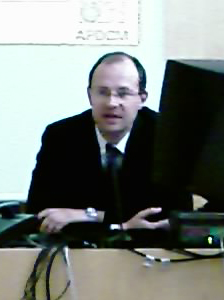 Francisco J. López Carmona
Francisco J. López Carmona
e-PRODAT is a European project aimed at promoting the exchange of knowledge and experiences between Agencies and other public bodies concerning the protection of personal data in Governments and Public Administrations, specially those related to e-Government, focusing in best practices in the sense of real world practices.
Public bodies must follow the law but also be cost-effective and act according to data protection while being realistic, practical.
Best practices areas: raise overall awareness among the citizenship, improve public information while providing public services, data needs minimization (optimization of data needs and managing, avoiding having to ask for more data each and each time, but also avoiding asking for more data on a “just in case” basis), ease the citizenship to execute his rights (in the field of personal data), let inclusiveness be an issue (data protection and digital divide).
Best practices identifies in e-Government and Data Protection: consent management infrastructures, privacy friendly identity management, data management, online services to citizens.
López Carmona briefly introduces dataprotectionreview.eu, a review whose name says it all ;)
Summary and Synthesis: Theory and Reality
Bill Dutton, Oxford Internet Institute (OII), University of Oxford, UK
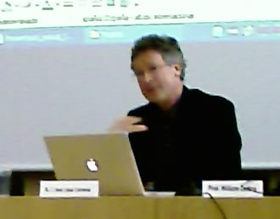 Bill Dutton
Bill Dutton
A first issue: e-Government should be a means, not a goal, but the matter is that due to e-Government we’re having data security concerns, hence e-Government debate is becoming a goal.
A second issue: noone can keep up with technologycal change. Passports were and have been unique IDs for years. Now, i.e. RFID based IDs will be obsolete long before they are even implanted. If technologies do not ease the way you’re doing things, what’s the sense in technology?
We’ve been talking about standards… but we cannot have one standard for each and every different service or public sector branch. This is not really one standard.
Change is right, but the economies of the public sector are not the economies of the private sector. So, efficiency should be though under this light, not under the competitive market light. And same applies when talking about ownership rights (i.e. of data).
Governments are due to provide (public) information to the citizenship, but the population does not go to governments but to “Google”, and this is a big concern in many ways: identification, trust…
Workshop. Fostering Innovation in eGovernment (2007)
By Ismael Peña-López (@ictlogist), 09 March 2007
Main categories: Cyberlaw, governance, rights, e-Government, e-Administration, Politics, Meetings, Participation, Engagement, Use, Activism
1 Comment »
Held at the IN3 headquarters in Castelldefels, Spain, on Friday March 9th, 2007, this open workshop of the MODINIS project, Breaking Barriers to eGovernment, will focus on ways in which innovation can be and has been achieved in eGovernment to improve governance in the information age. How can the widespread diffusion of the Internet and Web enable governments to transform not only the delivery of public services but also approaches to governance? The project has already identified 7 key categories of barriers to the development of eGovernment across Europe. This workshop turns attention to approaches for overcoming these barriers to stimulate innovation. These approaches span at least four key categories: legislative, technological, citizen-centric and organizational solutions.
Here come my notes for the third part of the workshop.
Identity Management (IDM) as enabler of e-Government
Mary Rundle, Berkman Center for Internet and Society, Harvard Law School, US
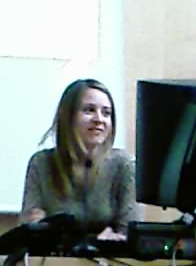 Mary Rundle
Mary Rundle
IDM is seen as part of the solution as governments try to: provide security (cybercrime, ISPs), guide foreign commercial relations, ensure reliable infrastructure, maintain jurisdiction (content, zoning), exercise monetary authority (flows, customs), ensure a clear system of property rights (IPR), recognize citizenship, facilitate relations between private parties (e-signature).
IDM systems: Federal Model (a third party or parties certificate your digital identity) vs. User Centric System (you hold your own digital identity). Which one is the best? How to bridge international personal data protections and the identity management infrastructure?
A proposal for an IDM system would be a CreativeCommons-like system that could be “human readable, lawyer readable, machine readable”, where all “features” (i.e. the data collected here can/will not be sold) could be tracked either by humans, at the regulation level or automatically by computers.
(Rundle gives a quick overview about NetDialogue)
Electronic Signatures
Miquel Peguera & Agustí Cerrillo, Internet Interdisciplinary Institute (IN3), Universitat Oberta de Catalunya
The researches present a study of the actual situation of the use of electronic signature in Europe, characterized by a trend to foster the use of e-signature:
- Strategies of electronic national ID cards holding digital certificates for authentication and signature purposes
- Legislative initiatives to demand specific procedures to be carried out electronically
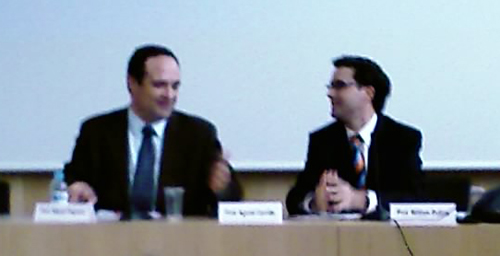 Miquel Peguera & Agustí Cerrillo
Miquel Peguera & Agustí Cerrillo
Electronic signature regulation is a basic issue to extend its use, because it allows guaranteeing the individuals and organizations’ rights, along with the proper use of the signature itself. In this field, there have been different ways to regulate its use, depending on who led a specific e-signature initiative, the already existing legal framework and the kind of system to be implanted (free access, login/password, certificate).
All in all, there is an evident lack of coherence and integration of systems all along Europe. Particularly stress is put in the fact that the choice of a particular system is directly related to the risks and menaces that this system brings with it, causing that overlapping systems might coexist to reinforce the strength of the protection.
To overcome e-Government barriers in the field of e-signature:
- There’s a strong need of political leadership, that should act as a motor of change
- Further from being only a duty, the use of the electronic signature should also be a right (fostering demand)
- Digital national ID cards, because of their major spread, are a good target to start with for e-signature purposes
- Also in the line of demand fostering, users motivation should also be enhanced
- Multi-channel delivery of e-government services requires different kinds of electronic signature with the same level of security
To conclude:
- e-Signature as a guarantee of the relationship among citizenship and the Government/Administration
- e-Signature as a mean to allow the citizenship enjoying their rights with confidence
Workshop. Fostering Innovation in eGovernment (2007)







